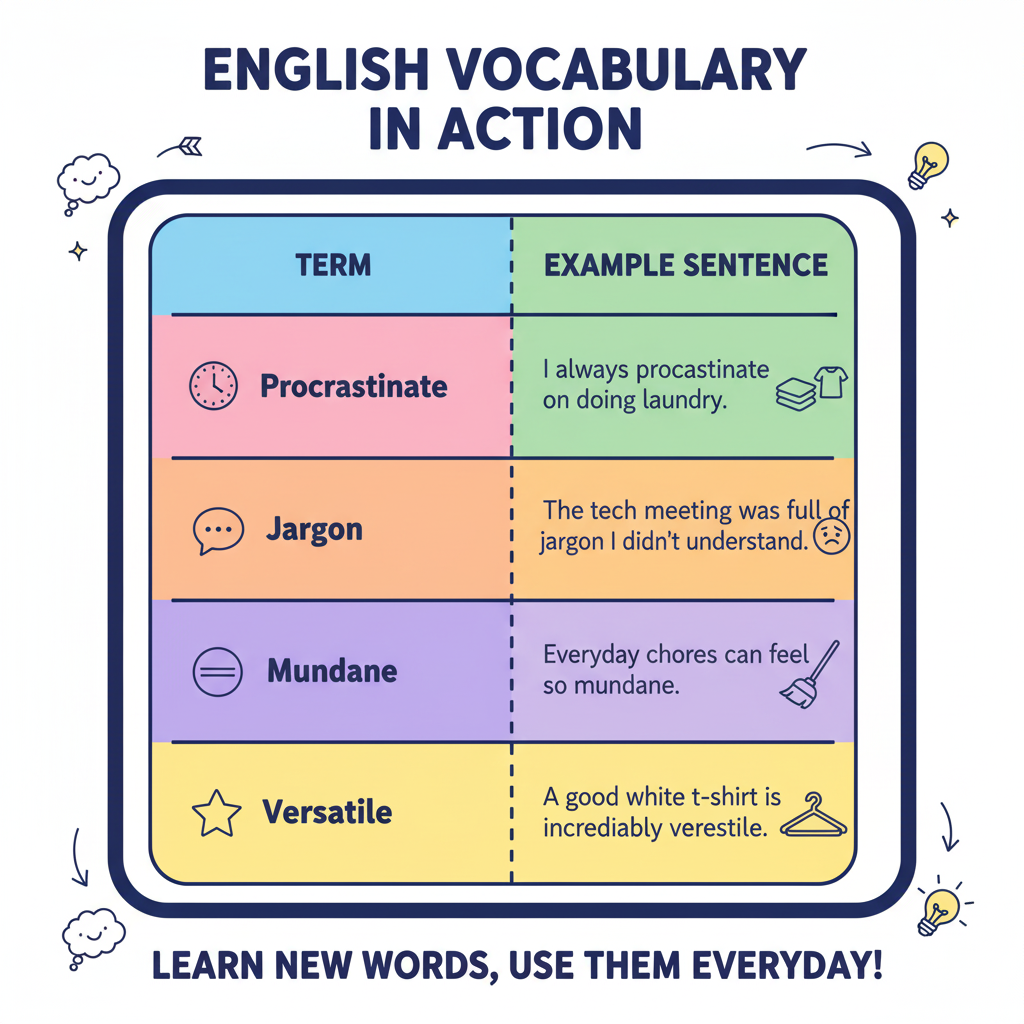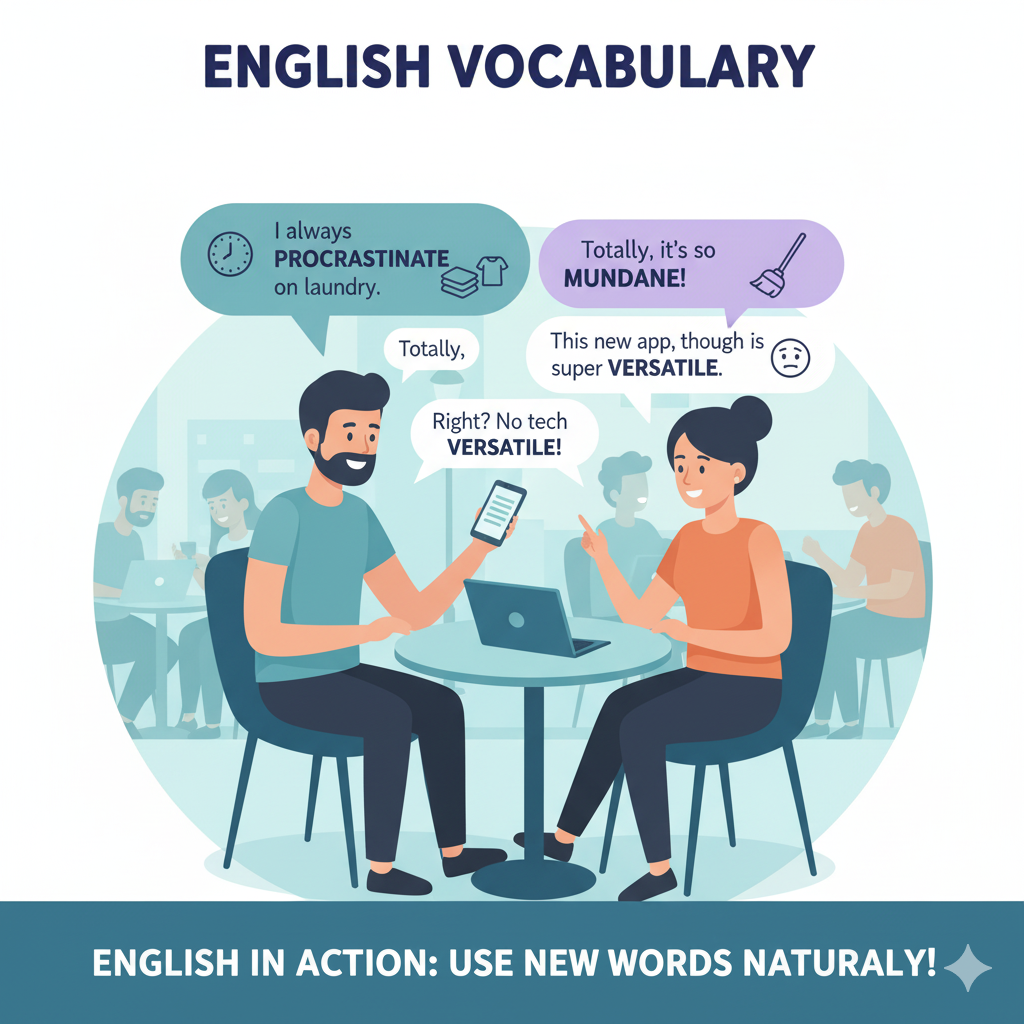Introduction
Think about this: the average person checks their phone 96 times a day. That’s once every 10 minutes. Crazy, right? It shows how much technology — especially smartphones and smart gadgets — is woven into our daily routines. From scrolling TikTok before bed to asking Alexa to remind us about groceries, tech is everywhere.

Now here’s the problem. Many learners get comfortable chatting in English about everyday stuff — ordering food, small talk, travel — but when it comes to tech, they freeze. Words like firmware, refresh rate, haptic feedback sound intimidating. And yet, if you want to write a gadget review, join a YouTube tech discussion, or simply talk about your new smartwatch with international friends, knowing these İngilizce teknoloji terimleri is essential.
So this guide is here for you. I’ll walk you through why these words matter, which ones you actually need, and how to use them naturally without sounding like a robot.
By the way, if you’ve ever struggled with confusing English words that look similar but mean totally different things, you might enjoy this read on false friends in English and Turkish.
Why Knowing Tech Terms Matters
Here’s the thing: tech audiences are sharp. If you’re reviewing the latest iPhone or discussing Samsung’s Galaxy lineup, they’ll instantly notice whether you’re using the right gadget terimleri. Misusing “resolution” or confusing “storage” with “memory” can make your review sound less credible.
Think of it this way: when a tech-savvy reader lands on your blog or YouTube video, they expect clarity. If you nail the vocabulary, they’ll trust you. If you don’t, they might click away to someone who sounds more professional.
It’s similar to using advanced grammar structures in English. Just like knowing how to use cleft sentences for emphasis can make your speech sound sharper, learning İngilizce teknoloji terimleri elevates your tech communication.
So, whether you’re writing a blog, scripting a gadget review, or just chatting with friends about the latest Apple Watch update, these words are your toolkit.
Common English Tech & Gadget Terms (Explained Like a Human)

Alright, let’s dive in. I’m not going to throw boring dictionary definitions at you. Instead, here’s how you’d actually explain these terms to a friend:
- Firmware – The hidden “brain” software that keeps your device alive. Ignore updates too long and suddenly your smartwatch can’t even count steps.
- Cloud computing – Just someone else’s computer storing your files. That’s why your selfies survive even if you drop your phone in the pool.
- IoT (Internet of Things) – When your fridge, speakers, and lightbulbs gossip online. Cool but also a little creepy. (More on IoT here)
- Wearables – Fancy word for gadgets you wear: Apple Watch, Fitbit, even AR glasses.
- Augmented Reality (AR) – Digital stickers on the real world. IKEA lets you see if that couch will ruin your living room vibe.
- Virtual Reality (VR) – A headset drags you into another world. Fun until you trip over your coffee table.
- Refresh rate – How smooth your screen looks. 120Hz feels like butter, 60Hz feels like lag.
- Haptic feedback – That buzz you feel when you type. Without it, your phone’s just cold glass.
- Bluetooth – The thing that makes wireless earbuds magical… when it works.
- AI (Artificial Intelligence) – Algorithms pretending to be smart. On phones, it usually means prettier selfies.
- Battery capacity (mAh) – Bigger number = longer survival. Unless you’re gaming nonstop. Then, good luck.
- Resolution – Pixel count. Do you need 8K on a phone? Nope. Will companies sell it anyway? Yes.
- Biometrics – Unlocking with your face or finger. Convenient, unless you grow a beard and your phone panics.
- Voice assistant – Siri, Alexa, Google. Basically your digital butler that sometimes misunderstands everything.
- 5G connectivity – Faster internet on the go. Amazing for cloud gaming, useless if your city doesn’t have towers.
- Charging port (USB-C, Lightning) – Where you plug in the cable. Apple clung to Lightning forever, but USB-C is finally winning.
- Operating System (OS) – iOS, Android, Windows… the software world your device lives in.
- Storage capacity – The space for apps, memes, and 10,000 cat photos.
Notice something? These akıllı cihazlar İngilizce terms are less scary when explained in everyday language.
How to Use These Terms Naturally
So how do you bring these words into your writing or conversations without sounding like a spec sheet? Easy: think context.

- In reviews: Instead of saying, “The screen has a 120Hz refresh rate,” say, “Scrolling Instagram on this phone feels way smoother thanks to its 120Hz refresh rate.”
- In casual talk: Rather than “It has advanced biometrics,” you’d say, “Face ID unlocks it super quick — even when I’m half-asleep.”
- In comparisons: “This model’s 5000mAh battery actually lasts me two days, while my old phone barely made it to dinner.”
The trick is mixing the technical term with a real-life scenario. That’s how tech YouTubers do it — they know their viewers want both the jargon and the human angle.
If you struggle with making your English sound natural, check out this piece on English collocations. It helps you avoid sounding like you copied straight from Google Translate.
Tech Terms vs. Social Media Slang
Here’s a common mix-up: some learners confuse tech words with internet slang. But teknoloji kelimeleri and social media language are totally different.
For example, “firmware update” is a serious tech term. “This app is lit” is slang. One makes you sound professional, the other makes you sound like a TikToker.
Both are fine in the right place. But if you’re aiming for credibility in a gadget review, stick with tech-savvy terimler. Slang belongs in casual chats or memes, not in a breakdown of Samsung’s new display tech.
If you want to explore how slang actually works, here’s a fun post: social media English terms like LOL, POV, IMO.
Conclusion
Technology isn’t slowing down anytime soon. From foldable phones to AI-powered cameras, new features keep rolling out, and with them, new words to learn. Mastering these İngilizce teknoloji terimleri will not only make you sound more confident but also help you connect with a global audience of gadget lovers.
So here’s my challenge for you: pick your favorite gadget — your phone, smartwatch, even your earbuds — and try writing a short review in English using at least five of the terms from this list. Post it on social media, share it in a forum, or just say it out loud to practice. The more you use the words, the more natural they’ll feel.
And if you ever feel stuck with phrasing, you can always get a boost from this grammar checker tool — it won’t write for you, but it’ll clean up the little mistakes that trip you up.
Tech is universal. Once you master the language for it, your English goes from “basic” to global-ready. 🚀
